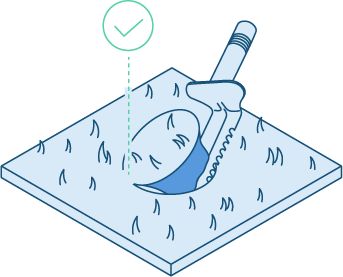
Metal Detecting Digging Techniques
Metal Detecting Digging Techniques
Many people will pass this article by thinking: “WTF! I know how to dig already!”. Hopefully we catch a few of you who want to learn a new trick or two. Here goes.
Pinpointing
Before you even dig your plug, you have to make sure you have ‘accurately’ pinpointed your target.
Pinpointing is easy when a target is isolated by itself, however, when you are in a trashy area it can be very challenging with multiple targets under the coil.
The detectors pinpointing feature will often get ‘dragged’ off by larger targets, or confused by multiple targets.
As iron erodes in the ground, it gives off a ‘halo’, which fools your detector and gives off a false signal. If you are trying to pinpoint a false signal caused by iron, you will likely end up digging in the wrong place and wanting to rip your hair out trying to find your target.
Instead of using the metal detectors pinpointing feature, try using a ‘cross-hair pinpointing method’ technique.
Cross-Hair Pinpointing Method
- Using the detector like a scalpel, get a tight sweep on either side of the target. Make sure the target tone completes itself and you find its strongest location on your coil.
- Remember to use a small tight wiggle, you are trying to isolate the size of the target.
- Now pin the center of your coil on top of the target, and pivot 90-degrees and do it again. Then repeat that one more time to be sure, and you have now made a crosshair in your mind's eye.
- Don’t let your eyes off that point, kneel down, and dig your plug around the hole. Sometimes I even put my finger on the center as I reach for my pinpointer and digger.
The Cross-Method will pinpoint any target much more effectively in my experience, and it can be much faster too.
We are trying to accurately pinpoint so that we don’t dig a huge ugly hole, or multiple holes to retrieve your target. This is where a pinpointer comes in.
(Below: this type of messy hole is fine if you are out in the wilderness, but not if you are in a park!)

Pinpointers
Pinpointers will come in handy because they will sometimes save you from digging at all!
For instance, your detector should give you modulated audio signals. Meaning, shallow or large targets sound loud, and deep or small targets sound faint.
If you come across a target that is obviously loud and on the surface, take your pinpointer and scrape it across the surface of the ground (make sure it is at its highest sensitivity level!).

When you hear the pinpointer go off, hone in on the target with the very tip of it so you know its precise location.
Next, just take the tip of your digger and dig in just in front of the signal/target, and ‘flip’ it out. This way a minimal amount of effort has been used, and minimal damage has been done to the grass.
Imagine how much easier that is than digging a huge hole just to have to fish a target out of your grass plug!
Another more obvious use for a pinpointer is finding a target that is located in the side of your hole. This happens most commonly when you have a nail in your hole.
My two favorite Pinpointers are:
Although I have not personally used them, I hear great things about the Fisher F-Pulse, and the XP Deus MI6. I do not like Minelab pinpointers.

Digging A Clean Plug
We metal detectorists like to dig clean plugs because we can leave little to no trace behind us, and give metal detecting a good reputation.
Digging a clean plug isn’t easy however. Clay soil, grassless hard-packed dirt, and mud all make digging a clean plug near impossible.
Let’s go over techniques for each one by one:
- Clay Soil is a lot like hard packed dirt. When you go to dig it it sticks to your shovel and skews the shape of your plug. It does not separate at all and often comes out in one giant clump. Using a shovel will make clay easier to leverage, and potentially get it out all in one clean plug.
- Grassless, Hard-Packed Dirt is usually exceedingly dry, and will just crumble and shatter as you attempt to dig a uniform plug. There is nothing holding it together, and it makes a broken mess. My only advice for this type of dirt is once you have retrieved your target, put the dirt shards back as best you can and stomp them down so it resembles something close to flat.
- Mud is everywhere out here on the west coast. If you don’t have a dirty detector and you're from the NW, you’re either cleaning it off between every hunt, or you just aren’t using it. Mud goes everywhere, all over the grass, your gloves, your detector, your digger. It’s a mess. Using a detecting towel to put the mud on is probably your best bet, but the towel will eventually become unrecognizable.
- Normal Grass is a breeze to dig in. But you don’t want to cut at an angle because you’ll kill the roots. Cut straight down. I’ve heard some say that leaving a section of roots connected (like a hinge) is also good for the grass. As you dig deeper in the hole, be careful not to just jab the hole like a serial killer, you might damage your target. Use your pinpointer to hone in on the target and carefully dig around it until it's out.
Using a Detecting Towel
A detecting towel is a very useful tool that you simply lay next to your hole when you dig a plug. Scoop your dirt onto the towel so when it’s time to fill the hole in you just lift and pour! This saves you the effort of raking your fingers through the grass to get all your dirt back in the hole.
(Below: sharp glass I removed from a hole. If approached by the law, or rangers, I show them things like this. I also use this image when asking permissions to show them how many dangerous things I pull from the ground)

Pack Your Trash Out!
This should be obvious. However I’ve seen guys throw their trash across the lawn! I’ve come across plugs that had trash or coins still in them! It doesn’t take any effort at all to put trash in your pouch and throw it away when you're done.
For one, you may be unmasking deeper targets that you will find when you sweep your coil back over the hole. Secondly, you’re doing something that gives metal detecting a positive reputation.

